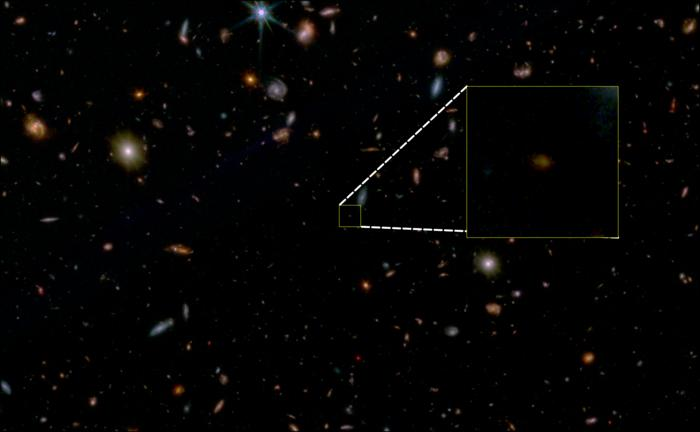The most important things are often those that are not seen, those that seem insignificant, like that tenuous gas that occupies the space between stars and galaxies and fills everything with hardly anything.
This material, which we know as the interstellar and intergalactic medium, is so fundamental that without understanding it we could not even begin to describe the way in which galaxies form stars or the universe is enriched with chemical elements.
Let's take a look at the basic ingredients of today's universe: 73% dark energy, 23% dark matter, and only 4% baryons (here we also include the leptons whose most famous member is the electron). Baryons are matter made up of neutrons and protons and represent the smallest fraction of everything there is, but because it is what we are made of and what we know best, we often call it normal matter. Now the question is, where are these baryons in the whole of the universe?
Since the beginning, literally, of time, baryons have collapsed under the effect of gravity together with dark matter to form the large structures that we observe in the cosmos: planets, stars, brown dwarfs and galaxies. Although these gigantic astrophysical buildings have not stopped growing, we only find a small part of the baryonic matter in them. Even now, 13.7 billion years from the beginning, we have that more than 90% of "normal" matter is in the form of cold gas, not found in stars or planets. Even gigantic galaxies only occupy one millionth of the total volume of the universe. In other words, only 0.4% of the universe is traceable matter from observations of the light emitted by galaxies and stars.The rest of the baryonic matter is found in the form of low-density gas in the interstellar medium and, especially, in the intergalactic medium. That gas, which fills everything, is very tenuous, which is why we say that the universe is and is, for the most part, empty, hence the name of our blog.
Baryons are matter made up of neutrons and protons and represent the smallest fraction of everything there is, but since it is what we are made of and what we know best, we often call it normal matter.
But how do we see that gas that fills the gaps between stars and galaxies? Obviously it is very difficult to detect unless you are in the proximity of an energy source that excites the gas. As this is not the case most of the time we have to resort to bright sources that illuminate it in the background. It is like turning on a flashlight on a foggy night. Our flashlights are bright and very distant objects like quasars, gamma ray bursts (GRBs), fast radio bursts (FRBs) or even other galaxies. These kinds of astrophysical beacons allow us to see the gas between them and us using certain spectroscopy techniques, often in the ultraviolet range and, therefore, with instruments in observatories in space.
But, the most wonderful thing is to understand the global importance of this diffuse gas that fills the recesses of things that shine with light. Let's start with the closest, the material between the stars and what we call the interstellar medium. To understand what happens on a large scale, let's imagine that we have a bottle like the one used by shipwrecked people, but in this case instead of a message, we place the characteristic matter of the environment it is passing through inside it. Our bottle here on Earth would have a thousand quintillion molecules in it. However, out there it would empty to only contain, under average conditions, between 1 and 1,000 atoms.
Now let's throw that almost empty bottle into the interstellar medium and follow the trail to see where our message goes. The first thing we observe is that it would not stay still, but orbits in the galaxy, and that over time the gas in the bottle becomes more or less dense, warms up and cools down. It can be found near a hot star and be ionized, and the star can explode like a supernova heating the gas in the bottle to millions of degrees and even sending it out of the galaxy. If it gets cold enough it can end up in a giant molecular cloud, fill and fill with material, and end up as part of a star. Only a third of the matter incorporated in stars returns to the interstellar medium and also a minimal percentage,perhaps as low as 1% of the hydrogen in the universe has ever been in a star.
What happens to our bottle if it leaves the galaxy is that it would become part of what we know as the intergalactic medium, and it would enter a fundamental cycle in astrophysics that we know as the baryon cycle. This baryonic cycle is responsible for the diversity of galaxies, with their masses, shapes and ways of growing stars that we see in the universe.
Galaxies are therefore the ultimate recyclers: they continually reuse huge volumes of hydrogen gas and heavy elements. Gas from the intergalactic medium is continually falling into galaxies, ours included, due to gravity. That gas is added to the interstellar medium that uses it to form stars. When these stars die, they explode and the combined effect of multiple supernova explosions on the scale of an entire galaxy heats and mixes the gas, expelling part of the interstellar medium into the intergalactic medium. That same gas is the one that can fall back into the galaxy as an immense cosmic source. Without this reserve of neutral and molecular hydrogen that constitutes the intergalactic medium, galaxies could not continue to form stars. This exchange of material with the environment on a galactic scale,the baryonic cycle, allows us to understand the formation and evolution of galaxies and build successive generations of stars over billions of years.
You can follow
MATERIA
on
,
and
, or sign up here to receive
our weekly newsletter
.








